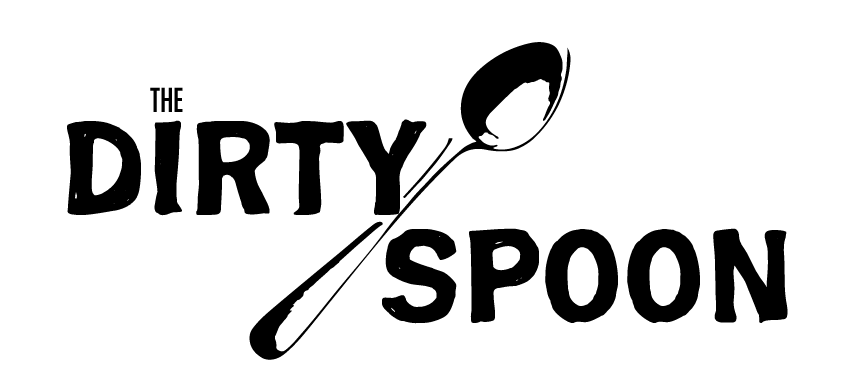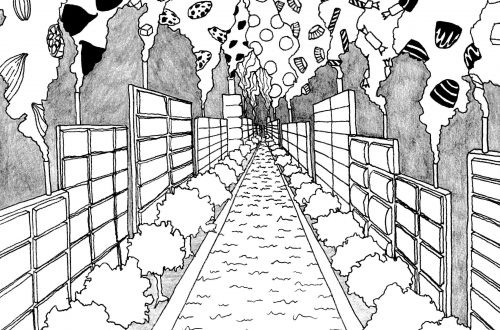by Jonathan Ammons
“Miami – Part One” appeared on Season 2, episode 1 of The Dirty Spoon Radio Hour, which aired May 3, 2019.
Sometimes you just wash up on the shore. There’s no plan, there’s no itinerary, there’s not even a goal or stated mission. You just suddenly find yourself there, on white sand beaches, looking out at an ocean of teal blue water. It’s a little bleary because of those rum shots at the bar, but you can still make out skyscrapers on the horizon. It’s February, but here you are: having abandoned the snowdrifts of your home just the day before, now with your toes in the sand and a strange sense of being. What is the opposite of a sense of purpose?
Miami is a huge city. Over five and a half million people stacked in high rises, cobbled within apartment complexes, or sprawled along the expansive towns on the outskirts of the city and islands. In those sprawls, those stretches of densely trafficked streets, you’ll find a very different America than anywhere else in the mainland.
Beginning in the 1950’s, Miami started to see a wave of migration. Up until that point, it predominantly was a city of Army brats and retirees. In 1950, there were a mere 172,000 residents. New York City had over 7 million by that same year. But revolutions, and political and societal turmoil in the clear blue waters to the south, were beginning to change the cultural and physical landscape of Miami, and by 2012, there were more than 1.2 million Cubans living in the city. That is to say: a 70% increase since 1960. The current population is over 5 million people in 6,000 square miles. Miami eventually earned the nickname “the Magic City” because of its Jack and the Beanstalk-like growth.
It’s a place where it has not been uncommon to hear entire city council debates conducted in Spanish. Where every Mayor since David Kennedy (‘70 and again in ‘73) had learned Spanish as their first language, and all of whom were born outside the US, either in Puerto Rico or Cuba. In fact, the city’s current mayor, Tomas Regalado, was born in Cuba and smuggled into the US at the age of 14 through Operation Peter Pan: a mass exodus of Cuban children in the early 1960s in which 14,000 children were brought into the U.S.
Understandably, there is a sense of discontent among the exiles residing in Miami, some of whom have seen firsthand the absolute horrors of fascism. The antipathy of a corporate structure grown to mammoth proportions, grinding its poorest under the wheel of progress and greed. Still, others have seen the opposite side of that spectrum; a communist regime insistent on absolute control, and resulting in the starvation of the very people it set out to liberate, corrupted by that same greed. Miami is a city of people who have been, or who are inalienably connected to someone, caught at some point in the swing of that pendulum hurled between two extremes.
Early on a Tuesday morning, heading down the hustle of 41, we can tell where we are headed based on the line out front. Versailles. A staple of Little Havana, what started as a bakery and cafe spread to become a culinary icon of the exiled community. At the front of the building, a small outdoor coffee bar, specializing in cafe cubano, serves up piping hot little caffeine bombs for the hoards of regulars every sunny morning.
We happen to arrive the night after the Iowa Caucus, a night when Ted Cruz eked past frontrunner Donald Trump by just under 3 points. Everyone is talking about it, in Spanish, of course. Holding their tiny espresso cups, puffing cigarettes and waving their arms dramatically. On the corner, sitting on the curb, an older man holds a copy of Diario Las Americas in one hand while stroking his mustache with the other, which also clutches a half-burned cigarette, the ash still holding on for life at the end of the tip. “Bah!” he calls out at one point, waving his hand in the air and shaking his head, almost tipping over the cafecito between his feet.
NBC morning news is there to ask patrons for their thoughts on the caucus.
“Did you all watch the Iowa Caucus last night?” the reporter asks. “Are you supporting Ted Cruz?”
“We’re Bernie Sanders supporters,” says Suzi.
“Oh… so you guys aren’t from Miami, are you?”
That answer seemed self-evident.
Behind the counter, the women in their green polyester suits, the same uniforms worn by staff here since 1972, crank out the cafecitos. A couple quick scoops of raw cane sugar into the tiny metal espresso pitcher, and then the inky black coffee. The heat from the dark roast hydrolyzes the sugar and creates a frothy texture. It’s silky and velvety. There’s a deep bitter flavor before finishing in a toasty sweetness.
I have not seen Suzi in four years before this trip. I did not know her all that well beforehand. But through the wonders of social media, we have grown to be friends. An artist, designer, and craftsperson, she is skilled in almost all visual mediums. She used to live in Asheville, but relocated to Orlando to be closer to her family. She’s also a career restaurant staffer, having worked both front of house and back of house at a myriad of establishments from the Carolinas to Colorado and now Florida. She shares the same belief that I do: food is the quickest route to the heart of a culture.
The dining room at Versailles has not changed in over thirty years. Drop-panel ceilings are fixed with massive crystal chandeliers. Bare Formica tables are sidled by metal chairs with faux-leather backs. The walls, the chairs: everything is the same shade of green, tan, or gold. Servers wear forest green uniforms with a tan stripe down their legs. The floor manager wears an all black pantsuit, walkie talkie and earpiece. At first we thought she was a security guard, the way she stood at the door at attention before waving her hand in the air authoritatively in the direction of the table that she, and the voice on the other end of that headset, have decided should be the prime place for us to break our fast.
The menu is sprawling. Selections from the bakery or the kitchen. Cuban toast slathered in butter. It’s flaky with a thin, brittle crust on the outside, and a pillowy, soft interior. Not unlike a baguette in its presentation, but the sharp contrast between the soft interior and the crispy exterior is a defining characteristic which can find no substitution.
I am admittedly not a breakfast eater. To me, a good breakfast is a handful of almonds and a banana. What can I say? Sometimes the pressing nature of my hippy Asheville background sneaks up on me in unexpected ways.
But when faced with a breakfast menu like the one at Versailles, it is impossible not to indulge. For me, it is the fried goodies from the bakery. Smashed potatoes stuffed with chili-laden ground beef and flash fried empanadas stuffed with chicken, or beef, or pork, or cheese, or a myriad of other simple, flavorful ingredients.Croquetas de Pollo, little crispy gooey balls of finely ground and creamy chicken. And Cuban tamales, with the sofrito beef drenching the top of the steamed corn, rather than being stuffed.
Suzi opts for a proper Cuban steak and eggs. Overeasy eggs next to a massive flat breakfast-cut steak the size of her head. There’s also little triangular polenta cakes, and more Cuban toast.
At the bakery, old men sit and sip cafecitos, snacking on pastries. There’s a line out the door with eager ticket holders awaiting something flaky and sweet. “Cuarenta y tres!” a voice calls out, and the corresponding ticket holder steps forward.
Suzi orders a flan to go. Stuffed as we are, we toss it in the car for later.
We decide to walk around. One block down from the sprawling mecca of Versailles are the green fields of Woodlawn Acres Cemetery. From the street, it’s just another pile of graves, a mix of Latin and Germanic names carved on intricate stones with distinctly Catholic imagery throughout the long yard. But to dig a little deeper is to unearth a history that is a telling picture of a Miami so often misunderstood, or damn right forgotten.
Carlos Prio Socarras was once the President of Cuba. In fact, he was the last democratically elected President in the country, and the first president to be born in a free Cuba. Known as el Presidente Cordial, Carlos Prio’s time in office was hardly a handful of golden years for Cuba. But it was considered to be a time of political freedom and, perhaps, the last time that people’s voices could be heard through their votes in the country, where one could freely speak their mind without the threat of persecution.
But the sordid scars of embezzlement and corruption under his rule eventually led rumors of a military coup. With no constitutional basis for resistance, Socarras did nothing, and on March 10, 1952, after four years in office, Carlos Prio, a member of the Cuban Revolutionary Party himself, was overthrown by Fulgencio Batista. It is said that those who live by the sword will inevitably die by it. Perhaps Socarras would agree the same goes for those who live by the constitution or the law. When the men with the weapons give no regard for the law, its service seems to tie its own noose.
Having fled just days before elections were scheduled in March of 1952, he lived until 1977, spending those days here in Little Havana. “They say that I was a terrible President of Cuba,” he once famously remarked. “That may be true. But I was the best President Cuba ever had.”
On a sunny 80-degree day in February, there are fresh flowers and tiny cups of Cuban coffee left as offerings in front of Carlos Prio Socarras’ six foot concrete headstone here in Woodlawn Cemetery.
And just over the crest of the stone, with the red, white, and blue colors of the Cuban flag proudly displayed, one can see the mausoleum which holds the ashes of General Gerardo Machado, another Cuban President, deposed in 1933. Carlos Prio himself, as a member of the CRP, had personally assisted in that deposition. But here they rest forever, less than a hundred yards from one another, neither in their home country, both with the same flag to mark their grave.
“Will you take the pain and live, or will you die and not have the pain?” Mac Klein once asked himself, bullet ridden on the side of a hill in France. “You know something, I’ll take the pain and live.” And live he has.
Mac’s Club Deuce is an institution in Miami. Just a block from the beach, and tucked behind a shady stucco wall with bright pink and green neon signs and blacked out windows, one could be forgiven for mistakenly thinking it was a strip club. In fact, much of the interior design was made to look like one when it was used as a set in the original Miami Vice television series. To say that the place is iconic would be a truly gross understatement say: the joint has been dolling out booze for a staggering fifty-one years, and its fearless owner turned 102 years old in September.
Mac Klein’s father couldn’t afford to send both little Mac and his brother to school, so from a young age the boy worked as a farmer in East Hampton, Connecticut. When World War II hit, he was deployed to France. Trapped behind enemy lines on a recon mission, Mac says he saw a tank moving in the distance, and before he could take cover, a machine gun bulleted him down. After returning to the States, Mac was advised that a warmer climate would be better for his health, and in the mid 40’s he moved, like so many GI’s home from the war, to Miami. Rumor has it that he still jogs to work in the morning.
The day his daughter was born in 1964, Mac came down to his regular bar, the Club Deuce, to celebrate with some friends, but the door was closed. The owner had died that same day. So Mac bought the bar to help keep the doors open on what he saw as the every day working man’s bar. This wasn’t a place for the tourists: it was a place for the locals, whomever they may be.
We go inside, and the Deuce is as dimly lit as ever. The only light radiates from pink and green neon reflecting the mirrors. An old man sits in the corner drinking a Budweiser, a cigarette butt poking through his fingers. It’s happy hour now (or in this case 6 hours of happy), which means that with every beverage, one is given a Club Deuce poker chip. That magical token is good for one drink. So a shot and a beer quickly turns into two for me, then four, then six. We start at one in the afternoon. It is complete and utter lunacy.
There is a classic photo taken from the exact vantage point where we are sitting. At the time of its taking, it was the height of the Vice era in Miami. At this point in the 1980s, the Deuce had become known as a haven for cast-offs from South Beach: people who didn’t fit the glamorous and flashy scene of Ferraris and Camaros to the South. And so it was that Tara, a member of Miami’s thriving transvestite community, gave her money to a man at the Deuce bar. The man purportedly held a pet iguana on his shoulder. Tara directed him to take the money, and procure some of the beaches’ famous white powder. When the man returned several days later sans drugs, as the Miami New Times reports, Tara began to beat the man with his own pet iguana, swinging it by the tail and screaming, “Give me my money, I want my money!”
Melissa Burley, the bartender working at the Deuce in the 80’s, reportedly filled in the rest. “‘Tara, put the iguana down!’ That was the funniest overheard line at the Deuce,” she told the Times.
Club Deuce is the kind of bar that opens at 11am, and does not close until 4am. After hearing the stories, I begin to understand why some folks just don’t leave until the sun comes up.
Stumbling back into the real world can be a bit of a shock. With already dilated and inebriated pupils, the glare of the sun, the roar of the traffic, the excited voices of passersby all seem to be moving at twice their normal speed.
Or is it that I am moving slower? Each pace, every step seemed weightless and aimless, as though taken at a lower state of gravity to where you floated momentarily before glancing the ground. A few blocks up and it’s out onto the beach where the haze of the rum gives everything an otherworldly glare.
It’s too bright to be real, it’s just too pretty.
Teal blue waters ripple white back towards the shore, where massive skyscrapers break up through the dunes. Each corner of each floor on every building boasts large wrap-around porches, giving the towers a zig-zag look on the horizon. As my feet hit the ocean water, and the brackish waves catch my linen cuffs, I can’t help but think: I could really get used to this place.
Our Miami trip continues in Part II here.






